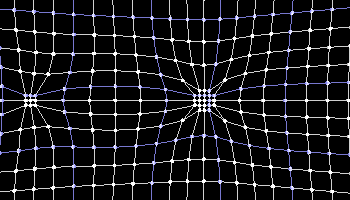A new scientific truth does not triumph by convincing its opponents and making them see the light, but rather because its opponents eventually die and a new generation grows up that is familiar with it.
- Max Planck -
Matter
To simulate a particle of matter, using my ether model, I merely had to bring a group of neighbouring nodes together. Figure 4 shows 21 nodes clustered together to form a particle. You can see that the surrounding ether becomes stretched and distorted as a result of this. (I will later explain how this distortion can be used to explain gravity.) To demonstrate how this distortion is created, I built a simulation to show a particle forming in empty space. I colored the nodes in red to show which ones will be used to form the particle. And because of the curled-up sticky nature of foamy ether, once these nodes touch each other, the surface tension prevents them from separating.

Figure 4
Of course, the act of a particle forming does not actually happen in nature. I only created the animation to show the ether in a clustered, or un-clustered state. These clusters (particles) were already in existence at moment of the big bang. Figure 5a is a simulation of what a small region of space would look like during the big bang if there were no particles. Figure 5b shows a similar animation that includes particles.

Figure 5a

Figure 5b
Now that I have a created a particle in foamy ether, let's see what it will look like when it moves. I created two animations: one of a slow moving particle (Figure 6a) and one of a fast moving particle Figure 6b). The fast moving particle gives you the illusion that something is actually moving across the screen. But when viewing the slow animation, it becomes apparent that it is only the distortion in ether that is actually moving. If you watch the slow animation carefully, you will notice that the ether itself does not actually get dragged along with the particle (I colored every 5th vertical set of springs green to make this more apparent). The particle pulls in the three neighbouring nodes from its right side, and then releases three of the nodes from its left side. That allows only the distortion to move, not the ether.

Figure 6a

Figure 6b
This makes ether theory inherently 'background independent', because the particles (distortions) move like solitons through the foamy ether. And the geometry of the ether is very dynamic as well because the distortion around the particle automatically adjusts whenever the particle moves.
Notice, also, that the particle jumps or jerks from one group of nodes to the next instead of moving smoothly (this is no coincidence). This jumping from one node to the next explains why a particle can only move in quantum steps - one ether node (or ether cell) at a time. Remember that I earlier defined the distance between neighbouring nodes as one Planck Length. Thus, quantum mechanics is naturally built-in to ether theory due to its foamy nature.
Now let's look at an animation that shows a two particle collision - like the collisions that happen in particle accelerators. Again, I created two animations: one of a particle collision at high speed (Figure 7a), and one of a particle collision in slow motion (Figure 7b). Both animations show a small particle coming in from the left and colliding with a larger particle. The impact causes the large particle to be broken into two smaller particles, which go shooting off to the right side of the window. Once again, you can see that no ether gets dragged along; only the distortions move.

Figure 7a

Figure 7b
